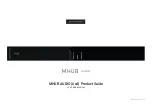
SYSTEM OPERATION
11
THERMOSTAT LOCATION
T
O
AVOID
PROPERTY
DAMAGE
,
PERSONAL
INJURY
OR
DEATH
,
SUFFICIENT
FRESH
AIR
FOR
PROPER
COMBUSTION
AND
VENTILATION
OF
FLUE
GASES
MUST
BE
SUPPLIED
. M
OST
HOMES
REQUIRE
OUTSIDE
AIR
BE
SUPPLIED
INTO
THE
FURNACE
AREA
.
WARNING
The thermostat should be placed approximately five feet from
the floor on a vibration-free, inside wall in an area having good
air circulation. Do not install the thermostat where it may be
influenced by any of the following:
•
Drafts, or dead spots behind doors, in corners, or under
cabinets.
•
Hot or cold air from registers.
•
Radiant heat from the sun.
•
Light fixtures or other appliances.
•
Radiant heat from a fireplace.
•
Concealed hot or cold water pipes, or chimneys.
•
Unconditioned areas behind the thermostat, such as
an outside wall.
Consult the instructions packaged with the thermostat for
mounting instructions and further precautions.
COMBUSTION & VENTILATION AIR REQUIREMENTS
Improved construction and additional insulation in buildings
have reduced heat loss by reducing air infiltration and escape
around doors and windows. These changes have helped in
reducing heating/cooling costs but have created a problem
supplying combustion and ventilation air for gas fired and
other fuel burning appliances. Appliances that pull air out
of the house (clothes dryers, exhaust fans, fireplaces, etc.)
increase the problem by starving appliances for air.
House depressurization can cause back drafting or improper
combustion of gas-fired appliances, thereby exposing building
occupants to gas combustion products that could include
carbon monoxide.
If this furnace is to be installed in the same space with other
gas appliances, such as a water heater, ensure there is an
adequate supply of combustion and ventilation air for the other
appliances. Refer to the latest edition of the National Fuel
Gas Code NFPA 54 / ANSI Z223.1 or CAN / CSA B149.1-15
Installation Codes or applicable provisions of the local build
-
ing codes for determining the combustion air requirements
for the appliances.
Most homes will require outside air be supplied to the furnace
area by means of ventilation grilles or ducts connecting di
-
rectly to the outdoors or spaces open to the outdoors such
as attics or crawl spaces.
INSTALLATION POSITIONS
This furnace may be installed in an upright position or hori
-
zontal on either the left or right side panel. Do not install this
furnace on its back. For
upright upflow
furnaces, return air
ductwork may be attached to the side panel(s) and / or base
-
pan. For
horizontal upflow
furnaces, return air ductwork must
be attached to the basepan. For both
upright or horizontal
counterflow
furnaces, return ductwork must be attached to
the basepan (top end of the blower compartment).
NOTE:
Ductwork must never be attached to the back of the furnace.
Contact your distributor for proper airflow requirements
and number of required ductwork connections. Refer to
“Recommended Installation Positions” figure for appropriate
installation positions, ductwork connections, and resulting
airflow arrangements.
Horizontal Applications & Considerations
2" 2" 3/8"
ANGLE
IRON
(3
PLACES
)
X X
Figure 2
Figure 2
When installing a furnace horizontally, additional consider
-
ation must be given to the following:
FURNACE SUSPENSION
If suspending the furnace from rafters or joists, use 3/8"
threaded rod and 2”x2”x1/8” angle iron as shown in the follow
-
ing diagram. The length of rod will depend on the application
and the clearances necessary.
If the furnace is installed in a crawl space it must be suspend
-
ed from the floor joist or supported by a concrete pad. Never
install the furnace on the ground or allow it to be exposed
to water.
FRONT COVER PRESSURE SWITCH TUBE LOCATION
When a furnace is installed horizontally with left side
down the front cover pressure switch tube must be
re-located to the lower port of the collector box cover.
1. Remove tube from front cover pressure switch and
collector box cover.
2. Remove rubber plug from bottom collector box port and
install on top collector box port.
3. Locate 24” x 1/4” tube in bag assembly.
4. Install one end on front cover pressure switch.
5. Route tube to lower port on collector box cover and cut
off excess tubing.


































